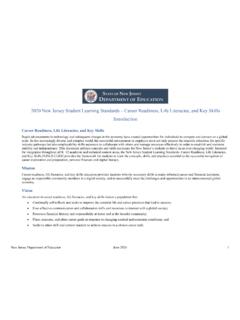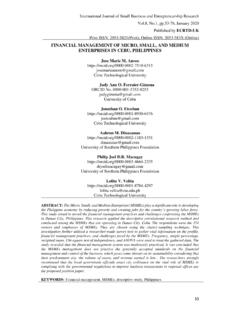Transcription of Adding Value to Agricultural Products
1 Adding Value toAgricultural ProductsDavid P. Anderson and Charles R. Hall* Value -added agriculture generates several billion dollars in economic impact forthe state of Texas each year. In fact, the economic impact of Adding Value beyondthe farm gate is usually several times the Value of Agricultural production at thefarm gate producers receive a much smaller portion of the consumer s dollarthan do food processors, especially those who produce brand name items ( ,Sunkist, Del Monte). Capturing those additional dollars or Adding Value to farm or ranch Products is a goal of many producers. Even for commodity Products ,such as beef, the farm-to-retail price spread indicates that those further up thesupply chain earn much more than producers at the ranch or farm level.
2 Thisleaflet defines Value -added activities, outlines the economic forces that makeadding Value important, and provides guidelines for starting your own Value -added is Value Added? Value added means Adding Value to a raw product by taking it to, at least, thenext stage of production. This can be as simple as retaining ownership of yourcalves and wintering them on wheat pasture or placing them in a feedlot. Valuecan be added through membership in a cooperative that processes your Products ,such as a cooperative cotton gin. Or, Adding Value may be as elaborate as going allthe way to the consumer with a case-ready food you are considering a Value -added enterprise, there are two key questions toanswer: 1) What is customer Value ?
3 And 2) What creates a Value -added product?What is Customer Value ? Customer Value reflects the relationship between the benefits customersreceive from and the price they pay for a product. The more benefits relative tothe price, the higher the customer Value . This does not necessarily mean thatgreater Value results from a low price. The price of a particular productmay be high, but if the associated benefits are high as well, the cus-tomers perceive Value in the product. This interaction creates cus-tomer Value and, thus, the opportunity to add Value to customer Value is critical in building a profitableand substantial business. However, one must bear in mindthat it is the customers perception of Value , not the produc-ers , that is critical.
4 Consider the case of pre-conditioningcalves. Does the cattle buyer perceive the pre-conditioning pro-gram as Adding Value ? That is, will the buyer pay more for pre-conditioned calves (enough to cover the added costs) than for othercalves?RiskManagementEducation L-5361(RM1-8)8-00*Assistant Professor and Extension Economist, and Associate Professor and Extension Economist-HorticulturalMarketing, The Texas A&M University SystemIt is also important to recognize that differentcustomers have different perceptions of addedvalue. These perceptions correspond to theirexpectations of quality, service, convenience Creates Added Value ? Value is usually created by focusing on thebenefits associated with the agribusiness prod-uct or service that arise from: Quality Does the product or servicemeet or exceed customer expectations?
5 Functionality Does the product or ser-vice provide the function needed of it? Form Is the product in a useful form? Place Is the product in the right place? Time Is the product in the right place atthe right time? Ease of possession Is the product easyfor the customer to obtain?A product must have one or more of thesequalities to generate additional Value . Rememberthat a product is simply a bundle of benefits,and that the more benefits there are the morecustomers will perceive the product as s Driving Value Added?Agribusiness, particularly the food sector, israpidly consolidating and increasingly respond-ing to the changing tastes and preferences ofconsumers. Consumers have higher incomesthan ever before. They are focusing more onconvenience, quality, variety, service, health,and social consciousness.
6 They are also facedwith the increasing Value of (and demands on)their time. In a nutshell, consumers are morevalue conscious than factors of rising disposable incomes andmarket fragmentation caused by retail consolida-tion exacerbate competition, but at the sametime leave many niche markets to be exploitedand create opportunities for producers to addvalue to their a Value -Added ProductTo take advantage of Value -added opportuni-ties, one must know and understand consumer segments might want yourproduct? What are the benefits desired by thesepotential customers? What criteria are they look-ing for when purchasing? Writing these down aspart of a business plan is an important first stepin beginning a Value -added business enterprise can be thought of asa Value chain.
7 Each activity that is performedshould add Value to the product. To do this, onemust meticulously control the activities at eachstep in the Value chain: procurement of inputs;converting inputs into Products ; marketing andsales; supply chain logistics; and customer ser-vice activities. A new Value -added businessshould focus on the product s uniqueness. Theuniqueness of your product or service (the valueyou add) is what ultimately attracts , this Value -added strategy is verydifferent from the commodity-oriented strategywith which most farmers and ranchers arefamiliar. In a commodity strategy, a producerfocuses on the costs of production with the goalof being a low-cost producer. This is, in essence,a supply-side Value -added strategy, in contrast, involvesa demand-side focus determining who thecustomers are and what they want.
8 Then, afterassessing your resources and source of unique-ness, you provide a product or service that effi-ciently curbs production costs while meeting theneeds of the potential market. Unlike a com-modity-driven business, a Value -added businesscan not erode benefits or lower input specifica-tions just to lower to success in Value AddedBuilding a new business is difficult and takeshard work (nothing new for farmers and ranch-ers). But, for all the uncertainty, there are waysto craft a successful Value -added business strate-gy. The key factors in a detailed business planare: Operations plan flow of the business,quality and cost control Personnel plan needs, skills and train-ing Sales plan including challenging butrealistic goals Management plan evaluate strengths,weaknesses and resources Investment and financial plan cashflow planningExamples of Value -Added AgriculturalProductsAs an example of Adding Value to an agricul-tural commodity, consider wheat.
9 Value can beadded to wheat grain in many ways. One way isfor farmers to produce wheat grain for use infeed or food Products . Wheat straw, a wasteproduct, can be harvested, processed and thenturned into building materials. Another way toadd Value to wheat is to graze it with stockercattle, which increases the yield of wheat bycausing tillering of the plant and also gener-ates income from the cattle operation. Wheatgrain also can be converted into organic naturalfoods and sold at health food may be hard to believe, but Value can beadded to woody plants such as cedar andmesquite. Cedar fiber can be used to makeboards and recap oil wells. Mesquite wood canbe used to make boards, jewelry boxes, lawnfurniture, and molding for floors.
10 The sawdustand fiber from cedar and mesquite can be madeinto fiberboard. South Texas Molding, Texas KilnProducts, and Uvalde Mesquite Company aresome of the firms that add Value to mesquitewood by making furniture and another example of Value -added opportu-nity is the fed beef industry. A rancher can addvalue by having a cow-calf operation or retain-ing ownership of his cattle through a feed option is producing specialty productssuch as sausage and tamales, or processingtongue and some of the viscera into menudo ortripas. Booker Packing Company, CavinessPacking Company, and J&B Foods are some ofthe companies Adding Value to meat successfullyin spite of processing recent survey of such companies indicatedthat their return on assets averaged 63 the firms in the survey, 42 percent had fewerthan five employees, 21 percent had salesbetween $50,000 and $250,000, and 26 percenthad sales of less than 50,000 pounds of meat peryear.






